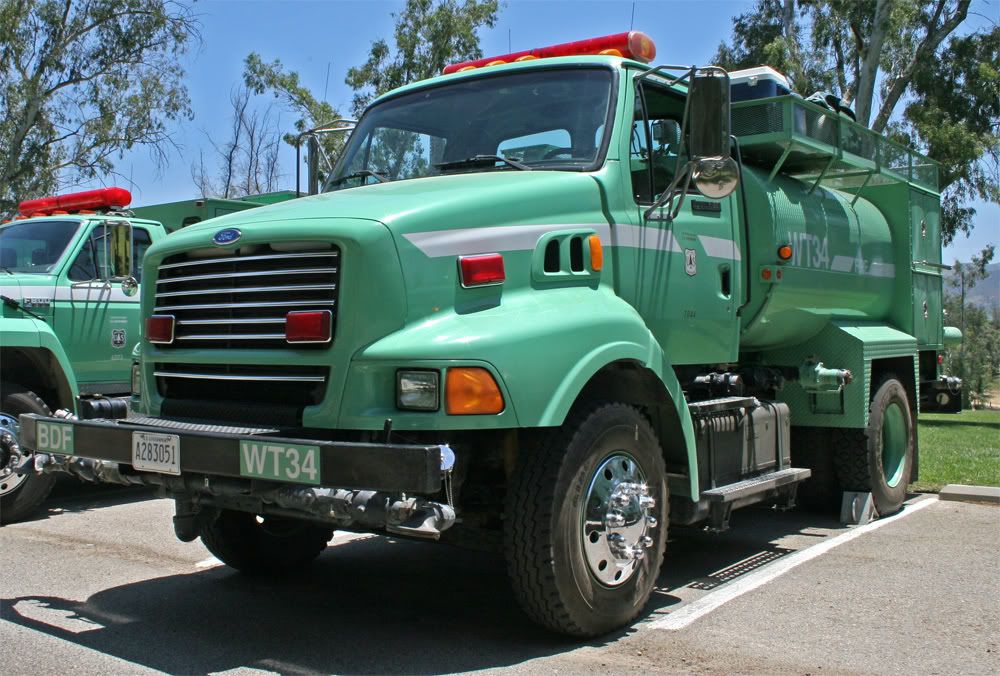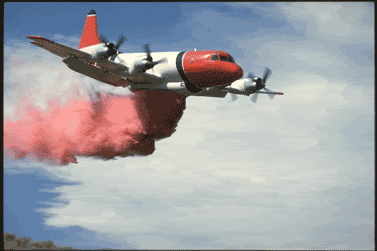My Firefighter Nation
Recently, while reading some of the FFN blogs, it appears that there is a flaw in our system(s) nationally when it comes time to define a vehicle that is used to bring water to the fire. The question posed here asks, "How do you define this type of vehicle? Is it a water truck, tanker or a tender?" Depending upon where you are located, these definitions may not match. So what's the difference? Does it really matter what we call these resource types? Are we all on the same page here? There is a difference... and it all has to do with whether you use USFS or NWCG ICS terminology or the NIMS terminology that does not include the word tender or tanker in the most recent online glossary... So, what do you call them?
Background Information:
The History of Incident Command System (ICS)
The concept of ICS was developed more than thirty years ago, in the aftermath of a devastating wildfire in California. During 13 days in 1970, 16 lives were lost, 700 structures were destroyed
and over one-half million acres burned. The overall cost and loss associated with these fires totaled $18 million per day. Although all of the responding agencies cooperated to the best of their ability, numerous problems with communication and coordination hampered their effectiveness. As a result, the Congress mandated that the U.S. Forest Service design a system that would "make a quantum jump in the capabilities of Southern California wildland fire protection agencies to effectively coordinate interagency action and to allocate suppression resources in dynamic, multiple-fire situations."
The California Department of Forestry and Fire Protection, the Governor's Office of Emergency Services; the Los Angeles, Ventura and Santa Barbara County Fire Departments; and the Los
Angeles City Fire Department joined with the U.S. Forest Service to develop the system. This system became known as FIRESCOPE (FIrefighting RESources of California Organized for Potential Emergencies).
In 1973, the first "FIRESCOPE Technical Team" was established to guide the research and development design. Two major components came out of this work, the ICS and the Multi-
Agency Coordination System (MACS). The FIRESCOPE ICS is primarily a command and control system delineating job responsibilities and organizational structure for the purpose of
managing day-to-day operations for all types of emergency incidents.
By the mid-seventies, the FIRESCOPE agencies had formally agreed upon on ICS common terminology and procedures and conducted limited field-testing of ICS. By 1980, parts of ICS had been used successfully on several major wildland and urban fire incidents. It was formally adopted by the Los Angeles Fire Department, the California Department of Forestry and Fire Protection (CDF), the Governor's Office of Emergency Services (OES), and endorsed by the State Board of Fire Services.
Three reference sources are quoted below that include both the USFS, NIMS and NWCG.

USFS Water Tender Definition: When water is required, water delivery is important. The typical water tender carries 1200 gallons of water to support the fire engines and crews. Water tenders even are used to fill water dropping helicopters when a lake or reservoir is not nearby.
NIMS Resource Typing
Tender, Foam (Firefighting Foam Tender)
The apparatus used to mix concentrate with water to make solution, pump, and mix air and solution to make foam, and transport and apply foam.
Tender, Fuel (Fuel Tender)
Any vehicle capable of supplying fuel to ground or airborne equipment.
Tender, Helicopter (Helicopter Tender)
A ground service vehicle capable of supplying fuel and support equipment to helicopters.
Water Truck (Tender)
A truck with a permanently mounted water tank with the capabilities of dispensing potable or nonpotable water. The dispensing is handled through gravity or pumped. For pumping action, the truck's engine or transmission is usually used to generate the requirement dispensing energy. Uses can range from delivering potable water to shelter locations, nonpotable form for irrigation, assisting in wildfire situations, dust control, compaction requirements, flushing of storm conveyance sanitary sewer lines, and washing areas of dirt, debris, and dust.
NWCG Definitions:

Air Tanker: Fixed-wing aircraft certified by FAA as being capable of transport and delivery of fire retardant solutions.
A DC-10 is seen above making a drop of fire retardant on the Zaca Fire in Santa Barbara County, CA. Normally, you don't see this large of an aircraft unless the threat is significant. If these planes do fly, all other aircraft in the area are evacuated both during and for sometime afterwards due to the dangerous vortexes of air that the DC-10 creates.
Air Tanker/Fixed-Wing Coordinator (ATCO): This ICS position is responsible for coordinating air tanker and fixed-wing operations over an incident and reports to the Air Tactical Group Supervisor.
Minimum Standards for Type 1-4 AIR TANKERS
Type 1 Tanker: 3,000 Gallons / C-130, P-3, DC-7
Type 2 Tanker: 1,800 Gallons / DC-4, SP2H, P2V
Type 3 Tanker: 600 Gallons / S-2
Type 4 Tanker: 100 Gallons / Thrush

Note: Don't know what they look like? Click here.
(Ref: NWCG* Handbook 3, January 1998, Appendix A)
*NATIONAL WILDFIRE COORDINATING GROUP
So... are we all calling these resources by the correct identifiers? It all depends on where you work and what standards you are following. But one thing for sure, if it carry's water then it's either a tender or a water truck. If it's flying in the air, it's always called a tanker which is the term used in aviation to described an aircraft that is used to refuel other aircraft in flight. We simply copied what the air force was using...
Stay safe and never stop learning!
Mike Schlags, Fire Captain
Santa Barbara, CA
mschlags@yahoo.com
.
Background Information:
The History of Incident Command System (ICS)
The concept of ICS was developed more than thirty years ago, in the aftermath of a devastating wildfire in California. During 13 days in 1970, 16 lives were lost, 700 structures were destroyed
and over one-half million acres burned. The overall cost and loss associated with these fires totaled $18 million per day. Although all of the responding agencies cooperated to the best of their ability, numerous problems with communication and coordination hampered their effectiveness. As a result, the Congress mandated that the U.S. Forest Service design a system that would "make a quantum jump in the capabilities of Southern California wildland fire protection agencies to effectively coordinate interagency action and to allocate suppression resources in dynamic, multiple-fire situations."
The California Department of Forestry and Fire Protection, the Governor's Office of Emergency Services; the Los Angeles, Ventura and Santa Barbara County Fire Departments; and the Los
Angeles City Fire Department joined with the U.S. Forest Service to develop the system. This system became known as FIRESCOPE (FIrefighting RESources of California Organized for Potential Emergencies).
In 1973, the first "FIRESCOPE Technical Team" was established to guide the research and development design. Two major components came out of this work, the ICS and the Multi-
Agency Coordination System (MACS). The FIRESCOPE ICS is primarily a command and control system delineating job responsibilities and organizational structure for the purpose of
managing day-to-day operations for all types of emergency incidents.
By the mid-seventies, the FIRESCOPE agencies had formally agreed upon on ICS common terminology and procedures and conducted limited field-testing of ICS. By 1980, parts of ICS had been used successfully on several major wildland and urban fire incidents. It was formally adopted by the Los Angeles Fire Department, the California Department of Forestry and Fire Protection (CDF), the Governor's Office of Emergency Services (OES), and endorsed by the State Board of Fire Services.
Three reference sources are quoted below that include both the USFS, NIMS and NWCG.

USFS Water Tender Definition: When water is required, water delivery is important. The typical water tender carries 1200 gallons of water to support the fire engines and crews. Water tenders even are used to fill water dropping helicopters when a lake or reservoir is not nearby.
NIMS Resource Typing
Tender, Foam (Firefighting Foam Tender)
The apparatus used to mix concentrate with water to make solution, pump, and mix air and solution to make foam, and transport and apply foam.
Tender, Fuel (Fuel Tender)
Any vehicle capable of supplying fuel to ground or airborne equipment.
Tender, Helicopter (Helicopter Tender)
A ground service vehicle capable of supplying fuel and support equipment to helicopters.
Water Truck (Tender)
A truck with a permanently mounted water tank with the capabilities of dispensing potable or nonpotable water. The dispensing is handled through gravity or pumped. For pumping action, the truck's engine or transmission is usually used to generate the requirement dispensing energy. Uses can range from delivering potable water to shelter locations, nonpotable form for irrigation, assisting in wildfire situations, dust control, compaction requirements, flushing of storm conveyance sanitary sewer lines, and washing areas of dirt, debris, and dust.
NWCG Definitions:

Air Tanker: Fixed-wing aircraft certified by FAA as being capable of transport and delivery of fire retardant solutions.
A DC-10 is seen above making a drop of fire retardant on the Zaca Fire in Santa Barbara County, CA. Normally, you don't see this large of an aircraft unless the threat is significant. If these planes do fly, all other aircraft in the area are evacuated both during and for sometime afterwards due to the dangerous vortexes of air that the DC-10 creates.
Air Tanker/Fixed-Wing Coordinator (ATCO): This ICS position is responsible for coordinating air tanker and fixed-wing operations over an incident and reports to the Air Tactical Group Supervisor.
Minimum Standards for Type 1-4 AIR TANKERS
Type 1 Tanker: 3,000 Gallons / C-130, P-3, DC-7
Type 2 Tanker: 1,800 Gallons / DC-4, SP2H, P2V
Type 3 Tanker: 600 Gallons / S-2
Type 4 Tanker: 100 Gallons / Thrush

Note: Don't know what they look like? Click here.
(Ref: NWCG* Handbook 3, January 1998, Appendix A)
*NATIONAL WILDFIRE COORDINATING GROUP
So... are we all calling these resources by the correct identifiers? It all depends on where you work and what standards you are following. But one thing for sure, if it carry's water then it's either a tender or a water truck. If it's flying in the air, it's always called a tanker which is the term used in aviation to described an aircraft that is used to refuel other aircraft in flight. We simply copied what the air force was using...
Stay safe and never stop learning!
Mike Schlags, Fire Captain
Santa Barbara, CA
mschlags@yahoo.com
.
Bill Muehsam
IT doesn't matter how much water your carrying, if it doesn't have the minimum equipment listed in NFPA, then its a tanker.
Sep 10, 2008
Ben Waller
When you say B-T-cadlow, you've said it all.
Sep 10, 2008
Brian Dumser
Sep 10, 2008